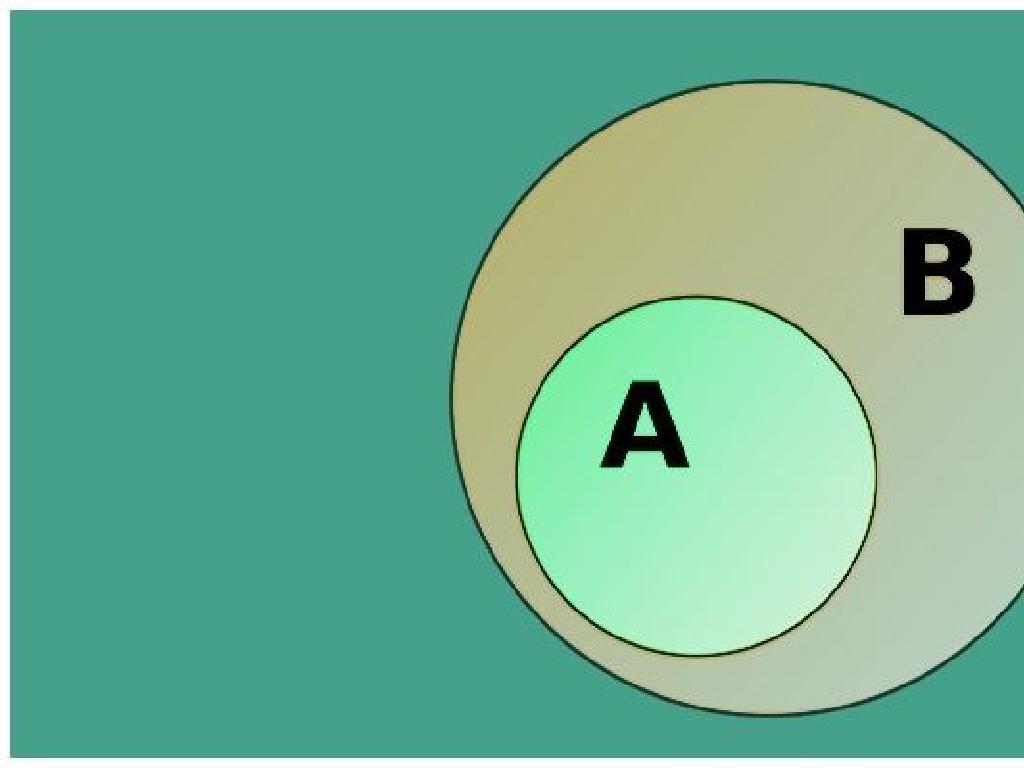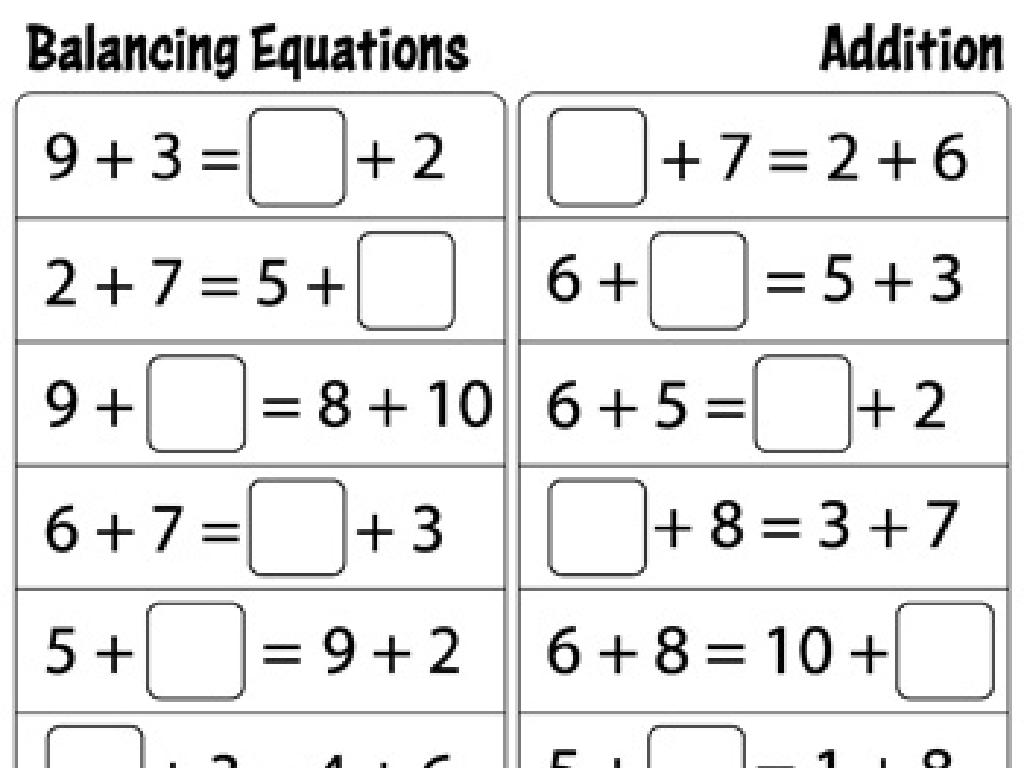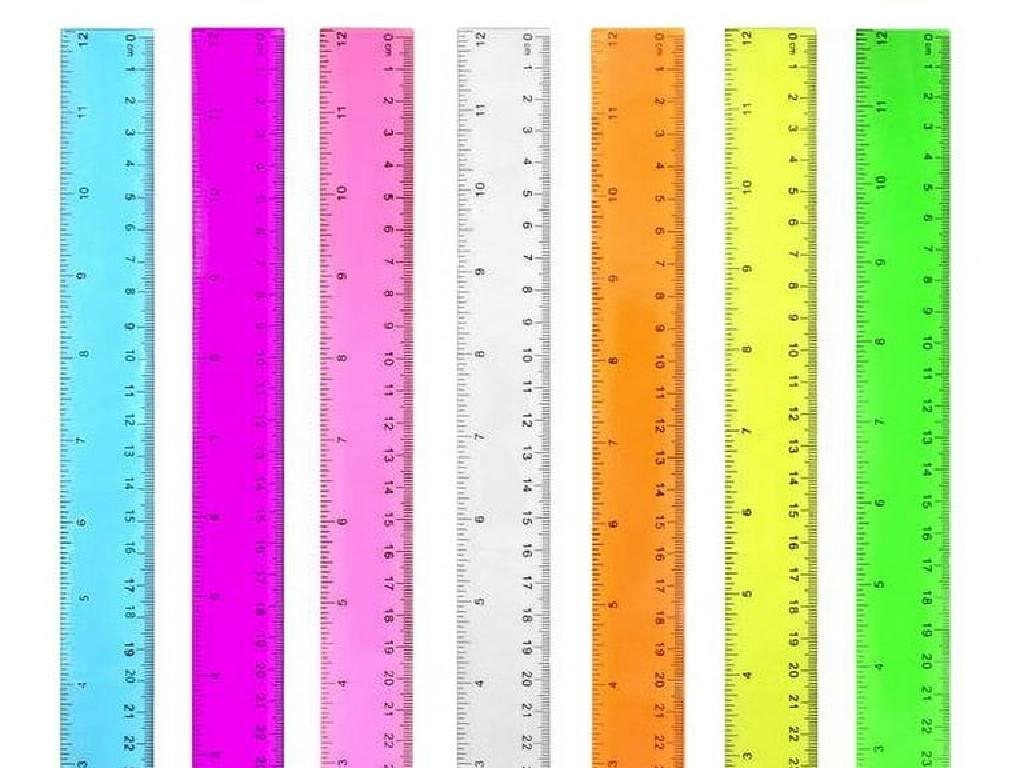Compare And Order Integers
Subject: Math
Grade: Seventh grade
Topic: Integers
Please LOG IN to download the presentation. Access is available to registered users only.
View More Content
Welcome to Integers!
– Understanding Integers
– Integers include whole numbers and their opposites
– Defining Integers
– Integers are the set of whole numbers and their negatives
– Positive vs. Negative Numbers
– Positive numbers are above zero, negative are below
– Comparing and Ordering Integers
– Use a number line to visualize and determine order
|
This slide introduces the concept of integers to seventh-grade students. Integers are explained as the set of whole numbers including zero, positive numbers, and their negative counterparts. Emphasize the difference between positive and negative numbers, using a number line as a visual aid to help students understand their placement and value relative to zero. Discuss how to compare integers by considering their position on the number line and how to order them from least to greatest or vice versa. Provide examples to illustrate these concepts, such as temperatures above and below freezing, or elevations above and below sea level.
Visualizing Integers on a Number Line
– Number line basics
– A horizontal line with numbers where position defines value.
– Integers in real life
– Elevations: Sea level (0), below (-), above (+).
– Plotting integers on a line
– Locate and mark integers on the line for visual aid.
– Ordering integers
– Compare positions to determine greater or lesser value.
|
This slide introduces students to the concept of visualizing integers using a number line, which is a fundamental skill in understanding and comparing integers. Start by explaining the number line, with negative numbers to the left, positive to the right, and zero at the center. Provide relatable examples, such as elevations above and below sea level, to illustrate positive and negative integers. Show how to identify and plot integers on a number line, reinforcing the concept that numbers to the right are greater. Finally, demonstrate how to order integers by comparing their positions on the number line. Encourage students to practice by plotting various integers and ordering them to solidify their understanding.
Comparing and Ordering Integers
– Understanding ‘greater than’ and ‘less than’
– Integers can be compared using > (greater) and -3 show how integers relate.
– Examples: comparing integers
– Compare -10 to 5, or -3 to -7, which is greater?
– Practice ordering integers
– Arrange -8, 3, -1, and 7 in ascending order.
|
This slide introduces students to the concept of comparing and ordering integers. Start by explaining the symbols for ‘greater than’ (>) and ‘less than’ (<) and how they are used to compare integers. Provide clear examples of inequalities, demonstrating how positive and negative integers can be compared. Use number lines if necessary to visually represent the integers and their relationships. Encourage students to practice by comparing pairs of integers and ordering sets of integers from least to greatest. This will help solidify their understanding of the relative values of integers and how to use inequalities to express these relationships.
Ordering Integers
– Sequence integers: least to greatest
– Arrange numbers in ascending order, e.g., -8, -3, 0, 7
– Sequence integers: greatest to least
– Arrange numbers in descending order, e.g., 10, 5, -1, -6
– Practice problem examples
– Solve given problems to apply sequencing skills
– Class activity: Ordering challenge
– Students will compete to order sets of integers quickly and accurately
|
This slide introduces the concept of ordering integers, both from least to greatest and greatest to least. Start by explaining that integers can be positive, negative, or zero and can be arranged on a number line. Use examples to show how to order them in ascending and descending order. Provide practice problems for students to solve individually or in groups, reinforcing the concept. Conclude with a class activity where students race to correctly order sets of integers, fostering a fun and competitive learning environment. This activity will help assess their understanding and ability to apply the concept quickly.
Rules for Comparing and Ordering Integers
– Understanding integer comparison
– Use a number line to visualize positions
– Strategies for ordering integers
– List integers in sequence to find order
– Memory aids for rules
– Acronyms or rhymes help remember rules
– Practice with examples
|
This slide aims to equip students with the fundamental rules for comparing and ordering integers. Emphasize the use of a number line as a visual tool to compare the relative positions of integers; the further to the right, the greater the value. When ordering integers, listing them out from least to greatest or vice versa can be a helpful strategy. Encourage the use of memory aids such as acronyms or rhymes to help students recall the rules more easily. Provide practice examples for students to apply these rules, such as comparing -5 and 3 or ordering -8, 7, -1, and 4. This will solidify their understanding and prepare them for more complex integer operations.
Let’s Practice Together: Integers
– Activity: Compare integers
– Activity: Order integers
– Group Work: Discuss findings
– Work in small groups to compare results
– Share answers with the class
– Each group presents their ordered integers
|
This slide is designed to engage students in hands-on activities to deepen their understanding of comparing and ordering integers. For the first activity, provide students with a list of integers and ask them to determine which is greater or lesser. In the second activity, students will arrange a series of integers in ascending or descending order. After completing the activities, students will form small groups to discuss their answers and reasoning. This collaborative approach allows students to learn from each other and clarify any misconceptions. Finally, each group will share their ordered list with the class, fostering a sense of community and collective learning. As a teacher, facilitate the activities, monitor group discussions, and ensure that each student participates in the sharing session. Possible activities could include comparing temperatures, bank account balances, or elevations.
Real-World Applications of Integers
– Comparing temperatures
– How do integers represent temperature changes?
– Monitoring bank balances
– What does a negative or positive balance mean?
– Understanding elevation levels
– How are integers used to measure above/below sea level?
– Applying integers in daily life
|
This slide aims to show students how integers are used in everyday life, making the concept more relatable and easier to understand. When comparing temperatures, integers help us understand degrees above/below zero, which is crucial for weather forecasts. In banking, a positive balance indicates savings, while a negative one signifies debt. Elevation levels are measured in integers to represent height above or below sea level, important for geography and various sports. Encourage students to think of other areas where integers are used and discuss how comparing and ordering these numbers help us make sense of real-world situations.
Class Activity: Integer Ordering Challenge
– Pair up and order a set of integers
– Present your ordered integers
– Discuss ordering differences
– Did everyone get the same sequence? Why or why not?
– Explore reasons for discrepancies
– Understand common mistakes or misconceptions
|
This activity is designed to promote collaboration and critical thinking among students as they work with integers. Provide each pair with a unique set of integers to order from least to greatest. After ordering, each pair will present their list to the class, fostering public speaking and presentation skills. Following the presentations, lead a discussion on any differences observed in the ordering of integers between pairs. This will help students understand common errors and reinforce the concept of integer comparison. Encourage students to explain their thought process and reasoning behind the order they chose. As a teacher, be prepared with guiding questions and possible misconceptions that may arise during the activity. Offer 4-5 variations of integer sets for different pairs to ensure a diverse range of examples for discussion.
Wrapping Up: Integers
– Recap: Comparing & Ordering Integers
– Why Master Integers?
– Integers are foundational for advanced math topics.
– Homework: Integer Worksheet
– Practice with problems to solidify understanding.
– Next Class: Integer Operations
|
As we conclude today’s lesson on comparing and ordering integers, remind students of the key concepts they’ve learned. Emphasize the importance of mastering integers as they are the building blocks for more complex mathematical concepts such as algebra. For homework, assign the Integer Worksheet to provide students with the opportunity to apply what they’ve learned in class. This practice will help reinforce their understanding and prepare them for the next lesson, which will delve into operations with integers. Encourage students to approach the worksheet with confidence and to reach out if they encounter any difficulties.






